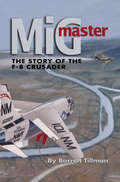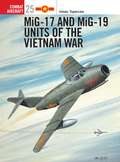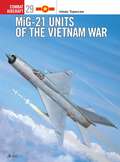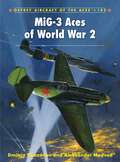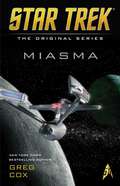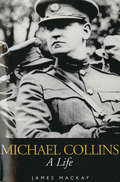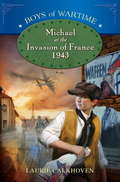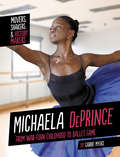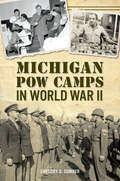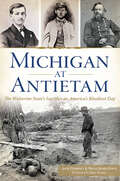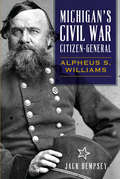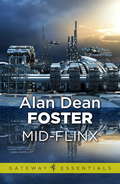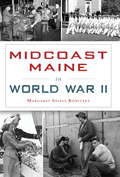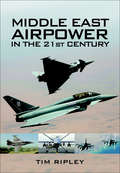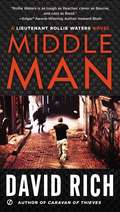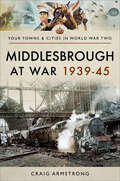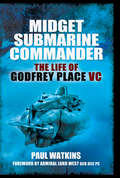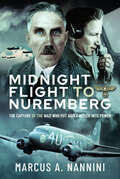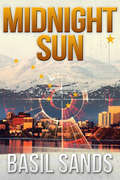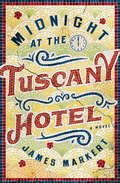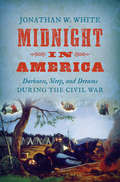- Table View
- List View
MiG Master
by Barrett TillmanTo be equally enjoyed by professional aviators and aviation buffs with limited technical knowledge, this biography brings to life the legendary aircraft that scored the highest kill ratio of any U.S. fighter aircraft in the Vietnam War. The book is filled with authentic re-creations of Crusader-MiG fights and vivid descriptions of the people and events that are part of the F-8 story, including John Glenn's 1957 record-breaking flight across the United States in three hours and twenty-three minutes. As the Navy's first supersonic aircraft, the Crusader holds an honored spot in carrier flying, and the author shows why it is called one of the most capable, versatile, and long-lived aircraft in naval aviation history. Barrett Tillman effectively combines an exciting account of the F-8's operational history with a detailed and authoritative explanation of its design, construction, and modifications. Tillman recalls the years of frustration and experimentation spent in refining the aircraft and its gunnery system, and then takes the reader through key actions in Vietnam where seasoned pilots handled their "rambunctious steeds" with scarcely a glance in the cockpit. Extensive appendixes provide further details.
MiG Pilot: The Final Escape of Lieutenant Belenko
by John BarronTells of the life of Lieutenant Viktor Ivanovich Belenko in Tokyo, Moscow and Tokyo and his secrets in regards to the Soviet Union.
MiG-17 and MiG-19 Units of the Vietnam War
by Iain Wyllie Istvan ToperczerThe erstwhile enemy of the USAF and US Navy during the nine years of American involvement in the Vietnam War (1955-1975), the Vietnamese Peoples' Air Force (VPAF) quickly grew from an ill-organised rabble of poorly trained pilots flying antiquated communist aircraft into a highly effective fighting force that more than held its own over the skies of North Vietnam. Flying Soviet fighters like the MiG-17, and -19, the VPAF produced over a dozen aces, whilst the Americans managed just two pilots and three navigators in the same period.
MiG-21 Units of the Vietnam War
by Mark Styling Istvan ToperczerOsprey's study of the use of MiG-21 Units in the Vietnam War (1955-1975). Having honed their piloting skills on the subsonic MiG-17 and transonic MiG-19, the Vietnamese Peoples' Air Force (VPAF) received their first examples of the legendary MiG-21 supersonic fighter in 1966. Soon thrown into combat over North Vietnam, the guided-missile equipped MiG-21 proved a deadly opponent for the USAF, Navy and Marine Corps crews striking at targets deep into communist territory. Most of the VPAF's 12+ aces scored their bulk of their kills in the MiG-21, which was then the best fighter produced by Russia's premier fast jet manufacturer, Mikoyan Gurevich. Well over 200 MiG-21s were supplied to the VPAF, and the numerous models and the schemes they wore are chronicled in great detail in this unique volume.
MiG-3 Aces of World War 2
by Dmitriy Khazanov Andrey YurgensonCreated by ex-Polikarpov designers Ivanovic Mikoyan and Mikhail Gurevich, the MiG-1/3 family of fighters was built to satisfy a Soviet Air Force requirement for an advanced, fast, high altitude fighter. Entering service in the spring of 1941, the problematic MiG-1 had its handling problems rectified with the hasty production of the MiG-3 - the latter had its Mikulin engine moved further forward, increased outer wing dihedral and a strengthened fuselage. As of 22 June 1941, Air Force manoeuvre units in the five borderline military districts could field 917 MiG-3s. Many of these were destroyed on the ground when the Germans launched Operation Barbarossa. Nevertheless, enough examples survived to allow pilots such as Stepan Suprun (Twice Hero of the Soviet Union), Aleksandr Pokryshkin (Thrice Hero of the Soviet Union) and Lev Shestakov (Hero of the Soviet Union) to claim a number of victories on the type. Early successes by units such as 23rd and 28th IAPs resulted in 35 aerial victories being claimed by MiG-3 pilots in the first eight days of the Great Patriotic War. Other units enjoyed similar levels of success, with MiG-3-equipped 15 and 31st IAP proving themselves to be the most combat-ready fighter units on the Northwestern Front. By the end of 1941, a handful of pilots had 'made ace' flying the MiG-3, despite the Soviet air forces having taken a fearful beating at the hands of the Luftwaffe. In 1942 MiG pilots actively participated in the defence of Leningrad, Moscow, Odessa, Kiev and Sevastopol, with still more aviators becoming aces as the year progressed. Amongst them was Aleksandr Pokryshkin, the second-highest scoring Russian ace with 59 victories to his name. He claimed his first five kills while flying a MiG-3 with 55th IAP. Stalin terminated MiG-3 production in October 1941, although the fighter remained in frontline service in large numbers until mid-1942. Surviving examples continued to serve with national air defence regiments until 1943.
Miasma (Star Trek: Vanguard )
by Greg CoxStar Trek continues its fiftieth anniversary celebration in 2016 with an all-new enovella from New York Times bestselling author Greg Cox, set in the popular and blockbuster Original Series era! The Enterprise-A is transporting a party of diplomats when it picks up a mysterious alien signal emanating from a nearby world. The planet’s dense, impenetrable atmosphere makes it unclear if the beacon is a distress signal, an invitation—or a warning to stay away. Spock, Doctor McCoy, and Chekov are part of a team sent to investigate, but an unexpected catastrophe forces a crash landing. Now the landing party is stranded on a hostile world, unable to communicate with the Enterprise. While Captain Kirk and Saavik race to locate the lost crew, a badly wounded Spock struggles to keep McCoy and the others alive until they can be rescued, even if that means making an unthinkable sacrifice. . . ™, ®, & © 2016 CBS Studios, Inc. STAR TREK and related marks are trademarks of CBS Studios, Inc. All Rights Reserved.
Michael Collins: A Life
by Dr James MackayThe most charismatic figure to emerge during the struggles for the independence of Ireland was undoubtedly Michael Collins. This remarkable biography, which draws on much hitherto unpublished material, charts the dramatic rise of the country boy who became head of the Free State and the commander-in-chief of the army.
Michael G Coney SF Gateway Omnibus: Mirror Image, Charisma, Brontomek
by Michael G. ConeyMichael Greatrex Coney was a British-born author who spent the last three decades of his life in Canada - including 16 years in the British Colombia Forest Service. His early work carried a sense of Cold War-inspired paranoia, but his repertoire was wide and perhaps his best novel, HELLO SUMMER, GOODBYE, is a wistful story of adolescent love on a far-distant planet. The titles collected in this omnibus come from the fertile beginning of his career and include his debut novel MIRROR IMAGE, CHARISMA and the BSFA AWARD-winning BRONTOMEK!
Michael at the Invasion of France, 1943
by Laurie CalkhovenWhen the Nazis invade Paris, Michael, a thirteen-year- old French-American, wants to be a part of the Resistance. Starting small, vandalizing Nazi propaganda and refusing to hail Hitler, Michael works his way into the full-blown Resistance, escorting American aviators to safe zones and delivering important spy documents. But when an injured pilot needs help to escape France, will Michael be brave enough to complete the mission? With historical notes, time lines, and maps to augment the page-turning action, it's easy to see why School Library Journal says Boys of Wartime "will appeal to history buffs and reluctant readers alike. " .
Michael's Discovery: A Selection From The Devaney Brothers: Michael And Patrick (The Devaneys #3)
by Sherryl Woods#1 New York Times bestselling author Sherryl Woods brings readers the third chapter in the classic tales of the Devaney’s… five brothers torn apart in childhood, reunited by love. Previously published in The Devaney Brothers: Michael & Patrick.For years, Kelly Andrews has buried her feelings for navy SEAL Michael Devaney. After a terrible accident that leaves him broken in body and spirit, she becomes the physical therapist assigned to his recovery, and may finally have her chance. But Michael’s injuries have left him deeply scarred, and he’s sure he’ll never be enough for her. As they work towards Michael’s recovery, can Kelly convince him that he’s all the man she would ever need? The DevaneysBook One: Ryan’s PlaceBook Two: Sean’s ReckoningBook Three: Michael’s DiscoveryBook Four: Patrick’s DestinyBook Five: Daniel’s Desire
Michaela DePrince: From War-Torn Childhood to Ballet Fame (Movers, Shakers, and History Makers)
by Carrie MyersMichaela DePrince was born in Sierra Leone and grew up in the United States. She rose to fame as a ballet dancer in the late 2000s. Learn more about DePrince's life as a famous ballerina!
Michelle Willingham Irish Warrior Box Set
by Michelle WillinghamLet Michelle Willingham sweep you away with four reader-favorite stories from The MacEgan Brothers, her epic family saga following gorgeous Irish warriors!Her Irish WarriorGenevieve de Renalt turned to fiercely powerful Irish warrior Bevan MacEgan only for protection... She didn't expect to lose her heart in the bargain! The Warrior's TouchConnor MacEgan is a fighter; it's in his blood. But when his hands are crushed in a brutal attack, he finds he may never wield a sword or touch a woman ever again. The only person who may be able to help him now is pragmatic, plain Aileen... Her Warrior KingBlackmail forced Patrick MacEgan into marriage--although he could not be forced to bed his Norman bride. But Isabel de Godred is as fair as she is determined to be a proper wife! Taming Her Irish WarriorHonora St. Leger secretly trained in order to prove she could wield a sword as well as any man. But when Ewan MacEgan steals a kiss from her, she succumbs to his forbidden embrace.
Michigan POW Camps in World War II (Military Ser.)
by Gregory D SumnerDuring World War II, Michigan became a temporary home to six thousand German and Italian POWs.At a time of homefront labor shortages, they picked fruit in Berrien County, harvested sugar beets in the Thumb, cut pulpwood in the Upper Peninsula and maintained parks and other public spaces in Detroit. The work programs were not flawless and not all of the prisoners were cooperative, but many of the men established enduring friendships with their captors. Author Gregory Sumner tells the story of these detainees and the ordinary Americans who embodied our highest ideals, even amid a global war.
Michigan at Antietam: The Wolverine State's Sacrifice on America's Bloodiest Day (Civil War Series)
by Jack Dempsey Brian James EgenThis Civil War study examines the role played by Michiganders in the Battle of Antietam, shedding new light on their sacrifices and contributions. The Battle of Antietam remains the bloodiest day in American history, and the people of Michigan played a prominent role both in the fighting and the events surrounding it. In Michigan at Antietam, Jack Dempsey and Brian James Egan—both Civil War historians and Michigan natives—explore the state&’s many connections to the historic conflict. Dempsey reveals the state's connections to the Lost Order, one of the Civil War&’s greatest mysteries. He also delves into George A. Custer's role as a staff officer in combat. Most importantly, he mourns the extraordinary losses Michiganders suffered, including one regiment losing nearly half its strength at the epicenter of the battle. The Wolverine State's contributions to secure the Union and enable the Emancipation Proclamation are vast and worthy of a monument on the battlefield. The authors provide research and analysis that shed new insights on the role of Michigan soldiers and civilians during the epic struggle.
Michigan's Civil War Citizen-General: Alpheus S. Williams (Civil War Series)
by Jack DempseyDetroit's Alpheus Starkey Williams never tired in service to his city or his country. A veteran of the Mexican-American War, he was a preeminent military figure in Michigan before the Civil War. He was key to the Lost Order, the Battle of Gettysburg, the March to the Sea and the Carolinas Campaign. His generalship at Antietam made possible the Emancipation Proclamation, and Meade and Sherman relied on his unshakable leadership. A steady hand in wartime and in peacetime, Williams was a Yale graduate, lawyer, judge, editor, municipal official, militia officer, diplomat and congressman who stood on principle over party. With vivid battlefield accounts based on extensive primary research, award-winning author Jack Dempsey's masterful biography tells the amazing story of this unsung hero.
Mid-Flinx (Gateway Essentials #379)
by Alan Dean FosterFlinx: born in controversy as the product of illegal genetic experiments. Flinx: raised an orphan in the streets of Drallar on the planet Moth.Flinx: the extraordinary young man with a rare flying snake for a companion, always the inadvertent centre of danger and galactic intrigue. Even on the backwater worlds of the Commonwealth, Flinx finds himself in trouble, as a rich local bully takes an unwelcome interest in the minidrag Pip. Fleeing into space, Flinx arrives on the strange planet of Midworld, where an immense kilometre-deep jungle is home to an incredible array of plant and animal life, all of it unknown and all of it deadly. It soon becomes apparent that his hiding place is rather more perilous than he bargained for...
Midcoast Maine in World War II (Military)
by Margaret Shiels KonitzkyWhile World War II raged overseas, the people of midcoast Maine responded with remarkable achievements on the homefront. The shipyard at Bath Iron Works launched a new destroyer every seventeen days. Bowdoin College had more military than civilian students and held three commencements per year. Boothbay Harbor, Bailey Island and Damariscotta all had military bases, and anyone who owned or sailed a boat was recruited for coastal defense. Women worked at machine shops, registered their neighbors for rationing and volunteered for the Civil Defense and Red Cross. Author Margaret Shiels Konitzky reveals the stories of local heroes and the relentless spirit of midcoast Maine.
Middle East Airpower in the 21st Century
by Tim RipleyThe Middle East is potentially the worlds major and most dangerous trouble spot. This book looks at why airpower is of such strategic and tactical importance in the area. It provides an overview of the state of the air forces in the first decade of the 21st Century. Each air force will be profiled, aerospace industries reviewed, major campaigns in the past decade are examined and the future airpower is discussed. The countries include Bahrain, Egypt, Iraq, Iran, Israel, Kuwait, Jordan, Lebanon, Oman, Qatar, Saudi Arabia, Syria, Turkey, UAE, Yemen and will also cover British and American operations. Each country is profiled with its air forces history, current status, order of battle, aircraft, ordnance and recent operations. Air campaigns of the 21st Century within the region are also described. The book includes many color and mono photographs, maps and diagrams.
Middle Man
by David RichDavid Rich-whose acclaimed debut, Caravan of Thieves, drew comparisons to Elmore Leonard, Robert Ludlum, and John le Carré-returns with a crime thriller featuring Lieutenant Rollie Waters. Recruited into SHADE, the elite, covert group formed by the U. S. military, Rollie Waters must locate and retrieve the countless millions taken from Saddam’s cache during the Iraq War and shipped home in the coffins of dead soldiers. But when a sniper attacks the team, Rollie is forced to go undercover to solve the riddle of the graves and to apprehend the puppet master behind the whole plot. Rollie’s own father, inveterate liar and charming con artist Dan Waters, was killed attempting to steal the first $25 million after stumbling across the conspiracy involving powerful military officers, would-be kings, and the very general who nearly destroyed Rollie during his last tour in Afghanistan. Rollie’s undercover quest takes him from Houston and the self-proclaimed king of Kurdistan, to the treacherous, labyrinthine streets of Erbil, Iraq, and into the arms of a stunning, enigmatic woman whose motives he can’t discern. As a confirmed citizen of the fog, now more spy than soldier, Waters must uncover the man pulling the strings behind a backdrop of murder, deceit, and stolen fortune-before he disappears forever into the mist. .
Middlesbrough at War 1939–45 (Your Towns & Cities in World War Two)
by Craig ArmstrongMiddlesbrough was of vital importance to Britain’s war effort. The town, and its surrounding area, contained a number of vital industries including shipbuilding, chemicals, iron, steel and other metals, and engineering, as well as a joinery firm that played a leading role in the wartime aviation industry. The ICI plant at nearby Billingham also played a leading role in the creation of petrochemicals and explosives. As with many communities, the start of the war saw Middlesbrough faced with hastily having to bring its Air Raid Precautions and civil defense services up to full strength. With its strategic importance it was believed that Middlesbrough would be an obvious target for the Luftwaffe. As a result, schoolchildren and other vulnerable people were evacuated from the town at the very start of the war in a scheme that did not prove entirely successful. Middlesbrough became the first built-up urban area in mainland Britain to be bombed. In the event, Middlesbrough was raided periodically throughout the war with the worst coming on the night of 25/26 July 1942, when waves of Luftwaffe bombers dropped almost 30 tons of bombs on the town. The raid killed sixteen people and caused very extensive property damage. Meanwhile, just days later, bombs fell on the town’s railway station as a train was waiting at the platform there. The pictures of the resulting damage were wired around the world.
Midget Submarine Commander: The Life of Godfrey Place VC
by Paul WatkinsOf all the acts of gallantry in World War II few were as audacious as the attack by midget submarines on the pride of the German fleet, the battleship Tirpitz, lying in her fortified mooring in a Norwegian fjord. Lieutenant Godfrey Place was in command of submarine X7 in September 1943 and traveled over 1000 miles, negotiating minefields and antisubmarine nets to accurately place four tons of high explosive under the hull of the Tirpitz. He was awarded the Victoria Cross in 1944, at the age of 22. Taken prisoner he was repatriated to England at the end of the war, and continued to serve in the Royal Navy for 25 years, flying with 801st squadron in the Korean War, and served on aircraft carriers at Suez, Nigeria and the withdrawal from Aden. On his retirement in 1970, he had the distinction of being the last serving naval officer to hold the Victoria Cross.Using many first-hand accounts, the book details his life, from a childhood spent partly in East Africa to being Chairman of the Victoria Cross and George Cross Association for over 20 years. It draws on previously unpublished material, including his own recollections on the attack on the Tirpitz and his time as a prisoner of war.
Midnight Flight to Nuremberg: The Capture of the Nazi who put Adolf Hitler into Power
by Marcus NanniniThe autobiography of C-47 pilot and instructor, First Lieutenant Harry E. Watson, Jr, USAAF.2022 IAN Book of the Year Awards, Third Place: Non-Fiction 2022 PenCraft Book Awards, Nonfiction - Biography 1st Place Winner 2021-2022 Overall Grand Prize Winner, Nonfiction, Readers Views Silver Medalist, 2022 IPPY Book Awards Finalist, 2022 Eric Hoffer Book Awards Finalist, American BookFest Awards This is the story of an American C-47 ‘Dakota’ pilot who earned three Air Medals, seven Battle Stars and flew twenty-seven combat missions during the Second World War. As a young U.S. pilot, Harry Watson, arrived in Britain as the Battle of Normandy was reaching its crescendo. Thrown immediately into the fray, Harry, along with more than 200 aircraft, set off to carry supplies to the troops fighting in France. But with visibility reduced to zero, the aircraft were ordered to turn back – all did except Harry, who successfully delivered his life-saving cargo of blood and US Army nurses. Harry continued to take risks, which resulted in many hair-raising episodes. This included almost being caught on the ground, while on an urgent fuel resupply mission for a platoon of General Patton’s tanks, by a German Mk.IV panzer and a battalion of supporting infantry. He flew throughout Operation Market Garden, losing a close friend to German anti-aircraft fire while taking some hits to his own plane. Thereafter he led a flight of five transports on a desperate mission to evacuate a mobile field hospital that was about to be over-run by the SS. Only four of the planes made it back as they came under direct fire just before they could take-off with scores of casualties and medical personnel crammed aboard each Dakota. Around midnight, in early April 1945, he was sent on a secret mission to fly to a point near Nuremberg, which was behind enemy lines at the time. It was necessary for him to locate an empty meadow in the dark, land, load a party of US soldiers and their captives, and then take-off again. He pulled it off. Among those prisoners was Franz von Pappen, the man who had persuaded President Hindenburg to make Hitler Chancellor of Germany in 1933. Von Papen had been seized at his own home by First Lieutenant Thomas McKinley and his men from the US 194th Glider Infantry Regiment. Based on his own recollections, as told to the author Marcus Nanni, this is Harry Watson’s exciting account of the air war told, unusually, through the words of a transport pilot.
Midnight Sun
by Basil SandsA former US government agent goes rogue in this nonstop thrill ride from an author who “is fearless in his storytelling” (Scott Sigler, #1 New York Times–bestselling author). They should’ve let him go. They should’ve let him retire in peace. They should’ve left his woman out of it.Kharzai Ghiassi has served the US Government his entire adult life. The best infiltration agent they’ve ever had. Death is not just his business, death is his life. He’s gone off the CIA’s radar and all they know is that someone is in danger.When a former soccer star turned Islamic terrorist shows up in Anchorage, Alaska, retired Marine Corps Special Operator Marcus ‘Mojo’ Johnson and his State Trooper wife, Lonnie, team up with the FBI’s Mike and Hilde Farris to put a stop to the threat that hangs over the city like a hammer about to fall. No one is safe. No one can hide in the Land of the Midnight Sun.Praise for Basil Sands and his thrillers“One awesome writer, penning stories pumped with enough adrenaline that you’ll suffer from insomnia until you read the last word. This is one writer not to be missed.” —Jeremy Robinson, New York Times–bestselling author“Basil Sands’s Ice Hammeris a gripping, can’t-put-it-down series that works at every level. It’s got it all: love, war, treachery, and heroism. A home run!” —John Gilstrap, New York Times–bestselling author“Basil Sands has a knack for blending action and intrigue in an all-too realistic setting . . . I just hope there are heroes like Basil’s heroes fighting on our side.” —Evo Terra, founder of Podiobooks.com
Midnight at the Tuscany Hotel: A Novel
by James MarkertA story of the power of memory, Midnight at the Tuscany Hotel explores the mysteries of the mind, the truth behind lore, and the miracle of inspiration.After thirteen months at war, Vittorio Gandy is haunted by memories, and his former life is unrecognizable. Once a gifted painter, now he can&’t bear the vivid, bleeding colors on a canvas. His young son doesn&’t remember him, and his wife, Valerie, is scared of him. But the most disconcerting change is in Vitto&’s father, Robert Gandy, who has fallen from being a larger-than-life sculptor to a man whose heart has been broken by the death of his muse—Vitto&’s mother—and whose mind has been taken by Alzheimer&’s. When Robert steals away in the night, Valerie, Vitto, and his new acquaintance and fellow veteran John go to the only place Robert might remember—the now-abandoned Tuscany Hotel, where it was once rumored that creatives of all kinds could find inspiration. When they find him there, Robert&’s mind is sound and his memories are intact. Before long, word gets out that drinking from the fountain at the hotel can restore the memories of those suffering from Alzheimer&’s and dementia. The rooms once again fill up with guests—not artists this time, but people seeking control over their memories and lives. Vitto desperately wants to clear his own mind, but as he learns more about his late mother&’s life and her tragic death, he begins to wonder whether drinking the water comes at a price.
Midnight in America: Darkness, Sleep, and Dreams during the Civil War (Civil War America)
by Jonathan W. WhiteThe Civil War brought many forms of upheaval to America, not only in waking hours but also in the dark of night. Sleeplessness plagued the Union and Confederate armies, and dreams of war glided through the minds of Americans in both the North and South. Sometimes their nightly visions brought the horrors of the conflict vividly to life. But for others, nighttime was an escape from the hard realities of life and death in wartime. In this innovative new study, Jonathan W. White explores what dreams meant to Civil War–era Americans and what their dreams reveal about their experiences during the war. He shows how Americans grappled with their fears, desires, and struggles while they slept, and how their dreams helped them make sense of the confusion, despair, and loneliness that engulfed them.White takes readers into the deepest, darkest, and most intimate places of the Civil War, connecting the emotional experiences of soldiers and civilians to the broader history of the conflict, confirming what poets have known for centuries: there are some truths that are only revealed in the world of darkness.
